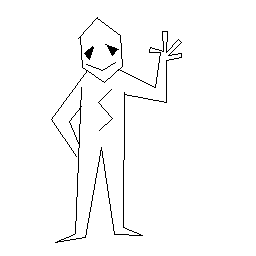HELLO:
Hello. If you are reading this file then I will tactfully assume you have purchased the 50 Short Games super bumper compilation package, which collects 50 short games made between 1st September and 31st December 2013.
Most of these games started out being in marker on a single index card, and then had a quickie soundtrack done in Terry Cavanagh's "Bosca Ceoil" program. They were assembled in MMF2 with considerable help from the default movement scripts in that engine and finally were exported via Fusion 2 Developer Edition as per commercial licencing guidelines. They were posted for free on the website glorioustrainwrecks.com which is a fine storehouse of many idiosyncratic personal interpretations of what a living videogame culture could look like.
The 50ShortGames EXE opens a loader menu where you can access all the games. The seperate EXEs are in the Games folder of the download. The controls for the games vary but in general are some combination of: mouse, mousekeys, arrow keys.
Here are some background details about the games for the curious and followed by an appendix that goes into specific topics at more length. You are probably better off playing the games first so that it won't matter if I take the mickey out of them here. Well, I hope you enjoy the collection and thank you for hypothetically purchasing this package which I hope will blaze a trail for increasingly baroque compilations of crude and unsaleable fragments in hobbyist game communities everywhere.
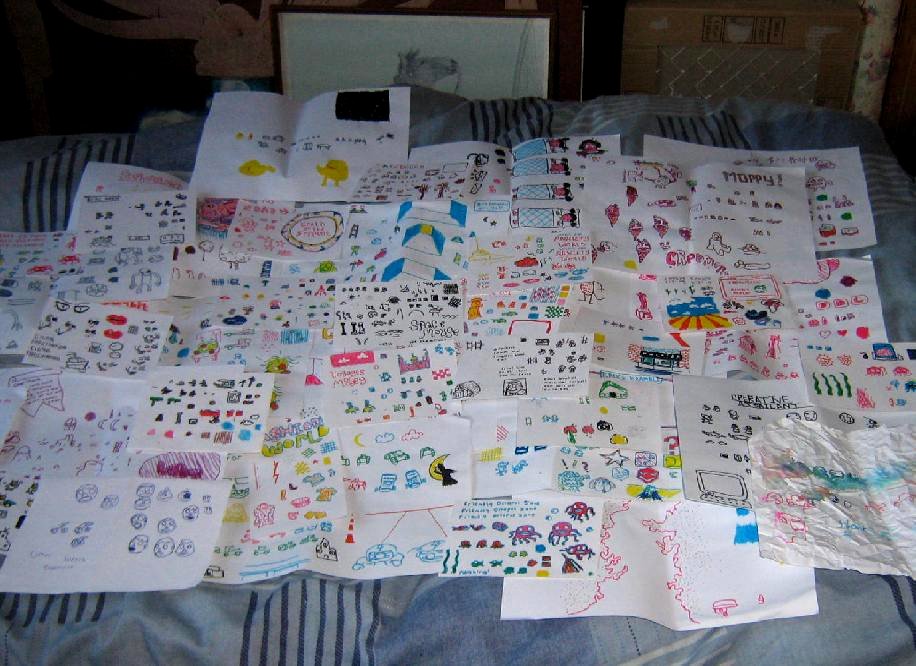
Some of the marker drawings.
NOTES ON THE GAMES:

MAGNIFICENT PLANET:
One of the projects I started and then gave up in early 2013 was going to be an astronaut game where you played as a bulky yellow thing called Meepo and explored different planets. It was kind of a precursor to these games in that one of the ideas was that it would be structured as a lot of different modular little experiences (representing diff planets etc) which would be chained up as they went along, to allow more looseness in structure and in working method. So, it made sense for me to use that character and some of that idea for the first marker game. The character design is based on me personally, as I similarly have a bulky upper body and tendency to squint.
The music was the first I ever made for any video game, EVER, and was intended to be just vague repetitive beeps to set a tone and give that extra sense of depth that comes with having sound (because it's being processed on two planes at once?). Science fiction planet exploration is a traditional testing ground for strange background sounds anyway, as witness Forbidden Planet.
The unexpectedly winsome monologue coda makes its first appearance here and will turn up in many, many more games.
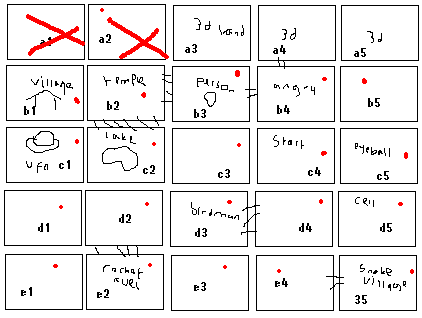
Sketched diagram of Magnificent Planet area layout.
SPACE MOUSE:
Based on Lilith Megiddo's game "Eternal Alien", which featured an overworld littered with holes which you could dive inside to trigger sidescrolling segments... I liked that structure because it was sorta compelling just to switch in and out of the different modes of perspective, and otherwise slight or banal areas (perfectly flat sidescrolling areas, etc) could still be engaging since they were contextualised as different little places of a larger world.
I also liked the idea of flavor text that would emphasise the rhythm of going in n out of these little holes, and music which would help enforce a distinction between inside/outside by offering a kind of louder and more disjointed retread of the world map theme (louder and more disjointed to reflect that the world is now more up close in these segments and trickier to navigate than the map...). Unfortunately the underground music is so shrill it's nearly unlistenable. Oh well.
This was my first platform game and I had fun messing around with the tiled block structures to make overgrown organic-looking cavern bits. This game also has a winsome coda for a second but then it collapses back into being an even more preposterous version of one of the underground segments, which could reflect either on the idea that the mice are too tired to maintain perspective or else that I was cranky at the time.
ANXIETY WORLD:
Meant to simulate late nite / early morning discombobulation feelings - being aware of different sensations as isolated self-contained systems reporting in to base, the hand out of the sheets, the pillow in yr ear, etc, as well as your consciousness which hasn't fully synced up yet and is still yipping away and chasing its tail on the porch. I'm late for work. What if I'm balding and don't know it. I should call my parents so they know they're still alive. The lil bit of actual gameplay (deflecting thunderbolts from the gathering cloud of conscious thought) is kind of a cop-out, though. I like the negativised graphics and the disconnected overwrought-looking sense organs. This is one of a number of games meant to represent the feeling of getting up in the morning, which I frequently find the most intense experience of the day.
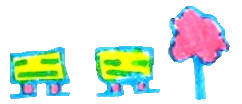
COWBOY LIVING:
I started to worry about falling into a formal rut w.r.t the actual mechanics pinning together the little games (I got over it). This was an attempt at a new perspective in a literal sense. Ironically I spent so long putting together the basic "walking system" and dialogue that I didn't really have time to put in any gameplay elements. I like it when the cowboy intones "Joooooohhhnnn Foooooooorrrrddddd" after silently gliding through the desert for a couple of seconds.
I've found that, strangely, putting an artificial frame around a 3d game (so that the 3d is viewed through a window within the larger game window itself) makes it more compelling to move around in it, I suppose because it's harder to identify your own viewpoint directly with the camera's and so the whole game ends up being processed on two levels at once, one where the player is the camera as it glides around and another where the player sees the camera as part of a larger frameworkk. See "Jungle Max" on glorioustrainwrecks for illustration... This approach was tried for this game as well but as the movement was so unconvincing to begin with it's hard to tell if anything was added.
CRITICISM ROUNDUP 2013:
Inspired by the Dick Tracy comics included in the Smithsonian Collection of Newspaper Comics which I had bought recently. I was impressed by the little cartoon people engaged in this surprisingly energetic, brutal gangland war pastiche. EAT LEAD COPPER! YOU PUT A PINKIE FINGER ROUND THAT DOOR AND I SWEAR I'LL BLOW IT OFF! RATATATATATAT! If you press Z in the opening bit you can shoot cops and trigger more dialogue. I don't know where the game criticism part of things came in... I guess I felt there was a similarity between both kinds of doomed, seething atavism. The ending is a classical EC Horror Comic style closure.
GLORY DAYS OF THE FREE PRESS:
Again inspired by the Smithsonian Collection of Newspaper Comics, this time by the notes about Hearst "Yellow Journalism".... I think a lot of literary modernism was the result of the newspapers (compressed language, montage and juxtaposition, an omnipresent written context to play off upon) so I liked the idea of those early hack tabloids being like experimental fiction innovators boldly pushing boundaries of language + consciousness via the format of very bad newspapers. I also love the cliche of the brusque newspaper editor with a heart of gold and it was fun to try and write in that style.
SOME BEE ESS:
All real dreams for what it's worth. I like the music. The ex-Laser store is still a gimmicky boutique stop. I don't think they use the basement anymore.
VOYAGES OF MOGEY:
I started out making relatively straight adventure games which were basically just an excuse to build colourful worlds with cardboard and paint and then be able to walk around in them. This was an attempt to get back to that a little, which is why it is more striaghtforward and rounded-out... all the dialogue is "in-character" as well, so no goofy juxtaposed monologues. "Mogey" / "Prince Mogey" is a name I used in some Goblet Grotto joke one time and liked... I still think the perfect name for a videogame protagonist is 1. two syllables long, 2. ending in a "y" or an "o", and 3. ideally consisting of two repeated syllables. Examples: Lolo, Mappy, Mr. Do, Wonder Momo. The endings to this came out more melancholy than I anticipated, but maybe that's just me.
After making this game I had the idea for a whole series of Mogey games, inspired by the Hans Castrop character in "The Magic Mountain" who is a kind of gormless nonentity who the various figures in the book, representing different schools of thought or modes of life, attempt to seduce by elaborate discourse... The idea would be that in each game Mogey gets hit on by the powerful demiurge figure of some strange videogame space (a castle-lady, a magic bird) and that exploration of that space with accompaning discourse represents their various attempts to win his affection ("Traitors are thrown into the pit of spikes!" "This room contains spikes of various colours" "In here, it is possible to just sit back and relax with the spikes").
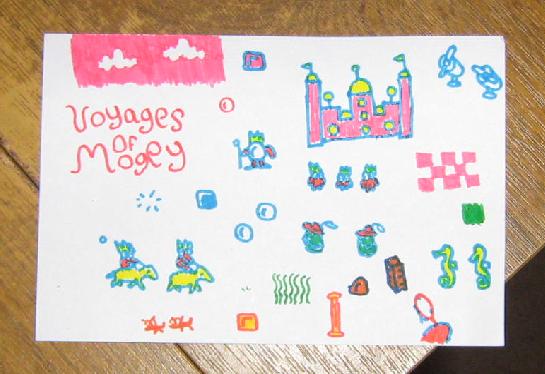
OCTOPUS DECISION:
Water levels in videogames are my favourite and I wanted to make a soothing water level where you could just float around... I had this idea for a while but didn't move on it because it seemed kinda boring. Also, I think I'd missed out on making a new game for the previous 2 days before this one and wanted to restart on something more substantive. I had the idea for the Anti-Octopus game after playing Air Fortress... octopuses were on my brain and I swiftly parlayed this into a despicable titular pun on the famous book. Once I had done the graphics though I felt uncertain again since the idea of a totally unreconstructed macho action game seemed kind of boring, especially done ironically or whatnot. So, the two games are bunged together.
NIGHT THOUGHTS:
I had a flu. The Wash Tubbs dream again came about as a result of reading the newspaper comics book.

Scribbled late-nite notes which would be assimilated into the Night Thoughts game.
FASHION WORLD:
I'd finished a 7-day game called Mystery Channel which was basically a collection of little horror-themed games and a loader (it's not included here, but it's free). Then after that I laid low for a week since I always "crash" for a couple days after releasing something longish, less from anything physiological than because I feel the universe owes me something now I guess. So this was gonna be a short game to get me going again.
I enjoyed drawing the bright colours and writing the descriptions... They started out being a vague parody of chirpy happy game instructions ("You can do it!") but I was enjoying writing them so much that they stopped being parody and started being for real. The game itself is unplayable due to poor collision detection... I only regret that you have to play it 5 times to get all the different ending texts.
KLOGG'S KRAPSACK:
Another result of my occasional worries about reusing the same default mechanics (four directional ovement, etc) over and over. It was intended to be a kind of garish, chattering toy that mixed straightforward game rules (push directional keys to move the crocodile in that direction) with weirder ones (pushing left key moves ghost #1 to the y coordinate of the crocodile, up key subtracts 16 from x coordinate etc) and random ones (button keys change around the icon things in the middle of the screen). It doesn't really come off as a baroque and unpredictable system so much as a goofy weightless one, though, which is fair enough. I like the baffled crocodile heading back off into the distance at the end....

GREAT! MOUSE FRIENDS:
The Soda Pop button text contains a typo: it references the mices' "rectitude", which is incorrect as mice are unable to form even basic moral codes. The proper word is "reticience". The original mistake has been left for this edition.
Another attempt to make a toy which just offers a kind of amusing space to amble around and poke at rather than tasks to complete. I like it, but there should have been an Earthbound / Pokemon-ish little jingle cue for the "sing to the mouse" option.
BOGEY'S REPORT:
A bad one. I wanted to make a piece of game writing that was itself a game and had little cartoon guys commenting on what they see as they drift around, similar to those old Disney dictionaries where Donald Duck explored the World Of Minerals ("Waughwaughwaugghhh"). Unfortunately I spent most of my time on the writing, not enough on the space and not nearly enough on the entire thing, so the crudeness of the game kind of negates anything potentially interesting that could be said in the dialogues.
HAPPY ASTRONAUT CITY:
Was just mistyped as "happy astronaut cutie", a far better game although I like this one too. For a while I was busy coming up with schemes to make sure the short games kept developing and evolving, before I became the bitter husk I am today, and to help in this I tried to read more stuff like Robert Lowell's sonnets and Donald Barthelme's short stories as both being examples of kind of loose, oddly structured, semi-ephemeral shortform works. It didn't take but I enjoyed them anyway and some of the phrasings here shows influence of both. The look of the astronaut base was partially based on the old Lego space base kits, all whites and atomic greens and little stubby figures poking at big cars and machines.
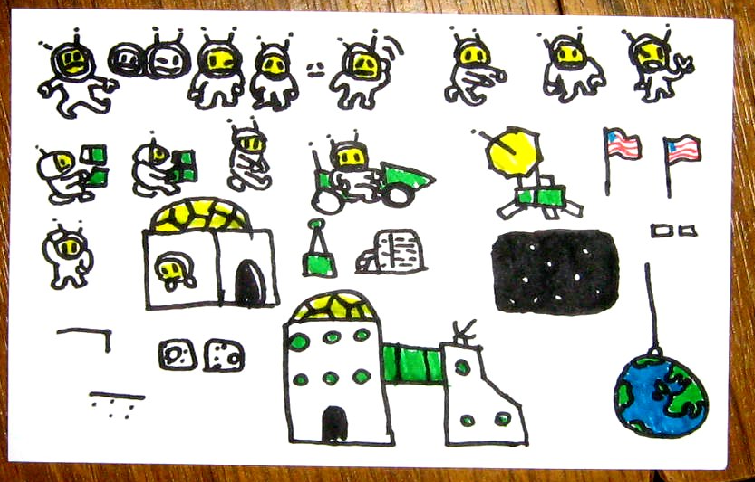
CIGAR AFFICIONADO:
This started off as a twine game but I switched it up because I had trouble hitting the tone I was looking for, a kind of exciteable pidgin lifestyle magazine crossed with pornographic repitition thing. Many videogames are structured like fetish pornography narratives anyway (constantly repeating scenarios increasing in intensity and duration in weirdo obsessive society focused on one activity (pog battlin')) (interesting sidenote: RPG Maker has a small yet thriving subculture of homebrewed tickling fetishism RPGs which are weirdly more "straight" genre exercises of the squaresoft rpg mold than many of the non-pornographic titles. What does this say about (a) RPGs (b) human sexuality (c) homebrew videogames? You have ten minutes). The "Buster" cigars in this are corruptions of an actual type of cigar, the "Robusta", and having it sound like Cloud Strife's sword is a happy bonus.
GARLO'S GAMBIT:
I was attracted to the tone of voice in this, a kind of old-boy's-club mixture of blimpish anecdote with something restrained and unfriendly in it. The title "Garlo's Gambit" is based on a vague memory I had of a newspaper feature mentioned in Ulysses called "Matcham's Masterstroke" ("Matcham often thinks of the masterstroke by which he won..."). The text and actions are more restrained than usual and I think this style could work well if extended.
WHICH WAY:
A marker-based revamp of a game idea I had earlier in the year, based on a cool wooden box I'd found: that idea was to use the box as the template for a room and then come up with a bunch of cardboard or plasticine props to drop around it to form a series of different areas, the joke being that within this template the nature of the rooms varied enormously (room interiors / landscapes / portraits / internal monologues / SHOP screens / dialogue boxes / etc). This version is smaller but still gets across the point, I think... Some of the songs were graciously contributed by my friend Lilith Megiddo who has many good games on her website cicadamarionette.com.

Outline for room arrangement in Which Way.
YARDDOGGZ:
I once told someone that this was my favourite marker game and he looked at me in bewildered horror and contempt. But it's the truth...
I like games that are brutally flat and trivial, but don't have that kind of ostentatious minimalism associated with art games or whatever. Just really closed-in and totally meaningless experiences that nevertheless have some kind of intriguing self-possession or poise to them. I think this works. Click on the dog to open a dialogue box. This is the best videogame I will ever, ever make.
The player character's sprite morphing as the game progreses was vaguely meant to represent the absent ebb and flow of thoughts when you wander around a park.
WRATH OF THE SERPENT:
Similar to Anxiety World, but instead of a monologue it's pieces of a rambling, hateful, disconnected argument between two people. It hopefully avoids pathos via the bizarre implication that the entire argument and discombobulated structure is the doing of a wrathful snake demiurge.
TALES OF TERROR:
Not based on the Roger Corman anthology but on the HC punk band of same name who were covered on Mudhoney's last album. I just wanted to make something really stupid and trashy to balance out the preciousness that some of this stuff tips into. The racing section at the start owes a lot of inspiration to the video of Judas Priest's "Turbo Lover".
OPERATIVE ASSAILANTS:
This was dreamed up while I was listening to the soundtrack for Auf Wiedersehen Monty, which is very dreamy and unnerving, this vague cartoonish melody stretched over strange abysses of electronic sound. This was mirrored in-game by the contrast between the incompetent agent taskforce and the faceless, omnipotent enemies they are working against. Bears undeniable resemblance to Leon Arnott's HTML5 games such as Tiny Sorceress, which can only be a good thing, although I didn't notice at the time. His games can be played here and I would recommend it: http://l.j-factor.com/gmhtml5/ .
Another note: this game is longer than usual due to it being made on a Saturday. General quality and length of the games varied throughout the week since on work days I usually came up with better ideas but had less time or energy to work them out.
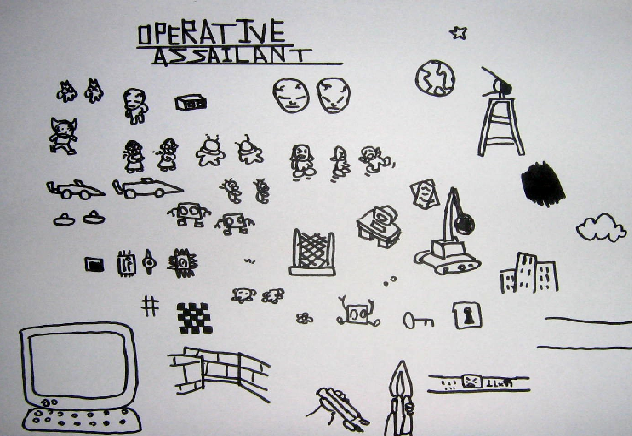
SEA OF LOVE:
Bears no relation to the song of the same name. I think the title was based on a variety of different old RnB / garage songs, though, like "The Enchanted Sea". Great minds....
Since I've already written an apologia for this game I may as well reprint it:
"Sea Of Love is a dating game inspired by the Pokemon series (specifically the areas Power Station, Mewtwo's Ice Dungeon I think I conflated). You walk around the little beach and go into a cave. You meet the animals and can seduce them via fruit. If successful they become "tamed" and sing a song to you. I had originally intended for the "tamed" animals to be added to your house on the beach but was too tired to implement this and also it seemed a bit pat (do we always kill the ones we love?? Can love bloom on the battlefield??). In terms of other content that didn't make it in, the encounter bits were going to be more interesting and also there was an excellent anemonae monster as well… with respect to the pokemon connection, originally this was going to be a more regular cave-based monster dating game but I felt that explicitly conflating romance with navigating a cavern full of leering underground slime monsters was too psychologically revealing and so the dating parts warped into a more general music / battlin' thing."
I should add that another reason I stripped back the dating elements was because I was wary of contributing to the misogynist tradition of representing femininity (as depicted here by sea monsters with long eyelashes, I guess) as something salty, slippery, protoplasmic, preverbal, a ghastly suckingness. See "Creamerz" for one I didn't catch in time.
This game was the first to introduce me to the delight of the MIDI tuba and as a result I feel fondly towards it.
NASTY:
The questionaire at the end is a direct steal from Samuel Beckett's "Watt":
"A rat, or other small animal, eats of a consecrated wafer.
1. Does he ingest the Real Body, or does he not?
2. If he does not, what has become of it?
3. If he does, what is to be done with him?"
The rest is essentially a supporting edifice for the central image in the first two seconds of Section 1.
It's said that the devil's greatest trick was convincing the world he didn't exist....................................
DOUG.ZIP:
In order to make it seem properly forlorn and abandoned I drew the graphics with my left hand, crumped them up and dripped water on them... Finding out you could drip water on marker drawings to create pastel blurs and spurts of colour was very exciting and I only regret I never had the time or motivation to take it further (it was the originally intended colour scheme for FF35).
STEPHENSTOWN:
Original idea taken from the song "Nowheresville" by David Thomas & two pale boys. I've always meant to try and represent Dublin more but I think this is the first time I've taken a whack at it, in whatever kind of discombobulated form. It's only actually shown in two places but they both work well for me, maybe just because I can recognise the actual areas they're based off of. My mental map of the city is mostly based around the Liberties as the list of neightbourhoods suggests so the Grand Canal, the Liffey, and various areas that a demographic-charting company I once dealt with at work would categorise without humour as "estates of old greys".

FF35:
I generally tried to come up with a fresh idea each day and to make a game on the same day I had an idea for it. This didn't always happen and there were a few ideas, like this one and Bogey's Report, that bounced around for a while before being used in dearth of others. These two specifically were games which kind of depended for effect on being couched in generic game spaces and thus required a higher amount of patience than I felt willing to give... FF35 is an especially poor one since faced with prospect of simulating a large amount of Final Fantasyesque scenarios I copped out and just rushed the player willy-nilly through vague outlines of each without really paying attention to the details.
I would like to register here my sincere admiration and fascination for the Final Fantasy franchise. The 35th entry in the series will be a plastic gun that plugs into your television and shoots you in the head. 10/10.
EMPLOYEE REPORT:
A lot of these games were thought up just before leaving to work in the morning since that's generally the point where I felt most engaged in the world. "The only thing real is waking and rubbing your eyes..." This was an attempt to simulate the feeling of a snooze button, falling back into depths of sleep but never able to capitulate to it completely and thus bobbing back and forth between the two states.
MOPPY RETURNS:
The canonical sequel to "Moppy Revives" http://trashbabes.com/lilith/GameAwordz.html. Title screen based on that of the sublime Door-Door ("How many aliens can you shut up?").
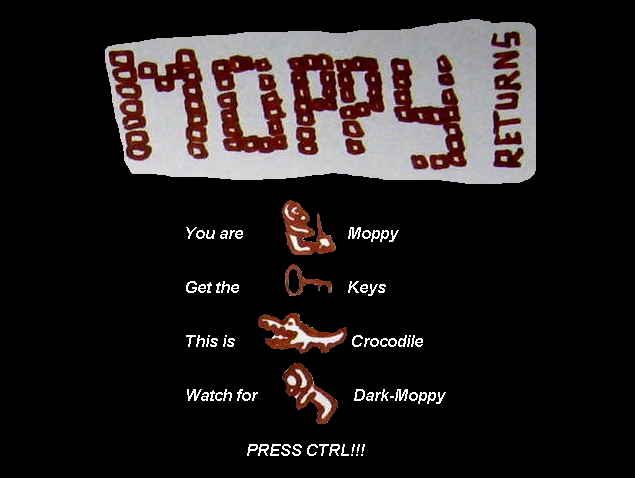
CREAMERZ:
Some kind of promotional picture-book exercise... Similar to "Fashion World" it started out being a joke about guilelessly chirpy commercial products but I ended up being charmed by just that quality (which is probably just as well, since it's kind of a curmudgeonly thing to pick at). I love the Creamerz.
UFO PANIC ATTACK:
BASED ON A TRUE STORY THOUGH DISAVOWED BY GOVT AGENTS OUR FULL-BODY SCAN REVEALS UNEARTHLY METAL CHIP IN BIG TOE.

MASHKIN SEES IT THROUGH:
Definitive evidence if required that hyperlink is a distinct medium with its own structuring mechanisms. Attempt to write "straight text" and plug it right in results in something bizarrely unreadable. Maybe it's just me... The prose is a kind of pastiche of some of Daniil Kharm's writing although not nearly as good: http://www.sevaj.dk/kharms/kharmseng.htm. I did my best to jumble any historical references.
PAMELA'S ADVENTURES IN DREAMLAND:
I felt like the last batch of games had been kind of drab and wanted to make something kind of goofy and cute. The big mechanical idea (that the spider crawling on the young girl's face changes the structure of her dreams) was not fully explored and I hope to make a 20-hour block puzzle game out of it by 2015. Her dream about a mysterious DVD store in a castle is probably based on one of my own, which all seem to centre around the accumulation of commodities.
After waking up once in the last year to find a big spider crawling on my arm I have become very rigourous about checking these things and will frequently lurch awake at 2am to flick on the light and quickly scan the bed in order to catch interlopers by disguise and hence this game pokes gentle fun of my neuroses on the subject. My life is a cage.

TOWN:
Based on visiting a friend in Texas in 2013, being driven down a highway for hours in her mom's car while the sun went down, past these big empty plains dotted with telephone poles and ambiguous farming / warehouse structures. This is another dopey toy but hopefully it gets across some of that sense of space.
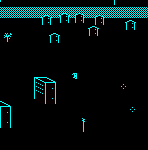
LUMP MAX:
Around this period and after a while of delicate manoeuvering on both sides I developed an understanding with a woman of my aquaintance and this was naturally reflected in the games I was producing at this time. "Physical self-loathing" is the basis for Lump Max while my previous experiences of "Courtship" were used for Meepo In Love. When I got home I no longer felt as awful as I did when I was coming up with the ideas so it's not really as turbulent as all that. After a while of flailing around it manages to resolve itself on a funny note.
CONTROID:
Being a cross between Contra and Metroid.
MEEPO IN LOVE:
Meepo appears again alongside his colleague Drizzly. This was partially inspired by my day job and the way that email relationships with people I wouldn't know to see could become strangely cordial over time. There's a mistake in the way one of the room transitions was put together but it actually works so much better than anything else in the game that I'm kind of ashamed of it.
FRANK TOMATO HD:
The concluding speech at the end drew mixed responses when I posted it with one person liking it and another feeling it ruined the thing. I personally had mixed feelings. I felt a truncated version, with only the first line of text remaining, was more evocative. But, I also dislike that type of evocativeness(sic??) in general and feel like ostentatiously minimal and wordless experiences enjoy a false cachet as being purer or more worthy than those contaminated with text (which is seen as some kind of a trick, which is why I like it). So having a kind of convoluted speech at the end that reframes the original experience is irritating but sometimes I like irritation, and prefer things that break themselves apart on the rocks of the verbal rather than hold themselves seperate in cloistered nunlike ineffability. However, I appreciate that this is a minority neurotic view. I truncated the text for this version of the game since I felt that having it in the context of all these other relentlessly chatty games meant I could afford to let the reigns slacken a little.
The original version is still available at glorioustrainwrecks.com and reads:
"- when frank tomato goes the forgotten valley lapses back into silence
- his was the last mission: "completed", all ties between the area and human use value have been severed.
- now divested of context - moldering dungeons house no treasure - the sprawling lake network home only to frogs - oddly persistent, a no-man's land. i come here, sometimes, just to listen to the BGM."

WORK DRINKS:
Authentic work drinks simulation. I thought of making some kind of techno pastiche for the music but was too tired and ended up just flashing "Bomp, Bomp" on screen.
SELF PORTRAIT:
In a notebook I have from when I was a kid, there is a terrifying drawing of a face: it is a kind of oval with big round empty eyes, a triangular nose, big expressionless lips, some wavy hair as an afterthought and a scar, all carved heavily into the page in pencil. I've always thought of it as my idealised self-portrait and it was the basis for the drawings here. I was happy enough with the mixture of colourful pixel background and biro lineart that I regret not going back to it.

Portrait of the artist as a young man.
DONALD FUCK:
Awful, pompous. Attempt at touching the same idea as Stephenstown and the way different neighbourhoods - imaginary, remembered, actual - can bleed together, and the idea that this intersection is a better picture of who you are than a list of personality traits. Be Ur Own Suburb. I should point out that the quotes from the Yeats poem at the start are not intended to be especially meaningful or a display of class or anything, actually the opposite: "Sailing To Byzantium" is taught in Irish high-schools in a way which requires students to learn a selection of the lines by heart, and their appearance here is meant to be just another piece of mental doggeral like the helicopters and the DooM monsters.
TRUCK NUTS:
Trying to get the last game out of my system in one of the periodic attempts to do something more crude and less precious. CLANG CLANG CLANG CLANG CLANG CLANGCLANG CLANG CLANG BEEP BEEP BEEP CLANGCLANGCLANG CLANG CLANG BEEP BEEP BEEP CLANG CLANG CLANG BEEP BEEP BEEP.
HAZY HAZY TOWN:
Another game based on music from Lilith Megiddo, this time on the basis that she'd send me a song and I'd make a game based on it. In this case it was more a game based on the track name, "Hazy Hazy Club". It's playing around with obscured screen similar to Wrath Of The Serpent. I like that the two main characters are ducks. Perhaps the most emotionally intense game in the collection as trying to keep the ducks from getting seperated is a difficult and heartbreaking affair, albeit one with no in-game consequences whatsoever.
The types of scenario represented here - going for drinks with an uncle, visiting a new city and wandering around it - are the kind I find most fascinating both in life and in media. The emotional flatlines rather than the highs and the lows. Similarly whenever I watch horror movies (about once a year) I'm less interested in the monster parts than in the exaggerated depiction of normal life that precedes them.
TRUE DETECTIVE MYSTERIES:
I was working on this game with a friend over and had a few drinks and was too tired to finish it, as well as too repulsed. I'm fascinated with kind of sordid little horror movie universes and the peculiar type of brainless, repetitive, numbing brutality that they threaten to turn into - where the violence is less upsetting than the feeling that there's absolutely no way back or no way of overcoming the momentum of the situation you're in - but at the same time they upset me and I disgust myself when I work with them. When I was making the "Drill Killer" game for Ludum Dare a year or two back, which is based on a similar feeling, I remember having this strange vertigious moment of clarity where I looked at the sunny day outside and looked at myself carefully drawing chopped up teenagers on a computer and thought "Oh my god, what am I DOING". This was similar. For the squeamish, there is no actual violence and part of the point was how the explicit murder imagery was kind of reduced and made more pointless and stupid by the sedate self-contained fields and woods that it takes place in. I don't know if any of that comes through at all.
ROBOT FACTORY:
Based on the Swell Maps song. The framing narrative at the start and end was kind of tacked on at the last minute and was based on an excellent story from the FOUR-COLOUR FEAR anthology of old 50s horror comics. It was a story about a plan to turn all the corpses of the world into zombies which would then take over but the kicker for me was the cheerful narration: "Hello! Let me tell you about a dream I had last night!". This turned the rest of the otherwise fairly routine story into something more interesting, a kind of disguised psychological portrait...
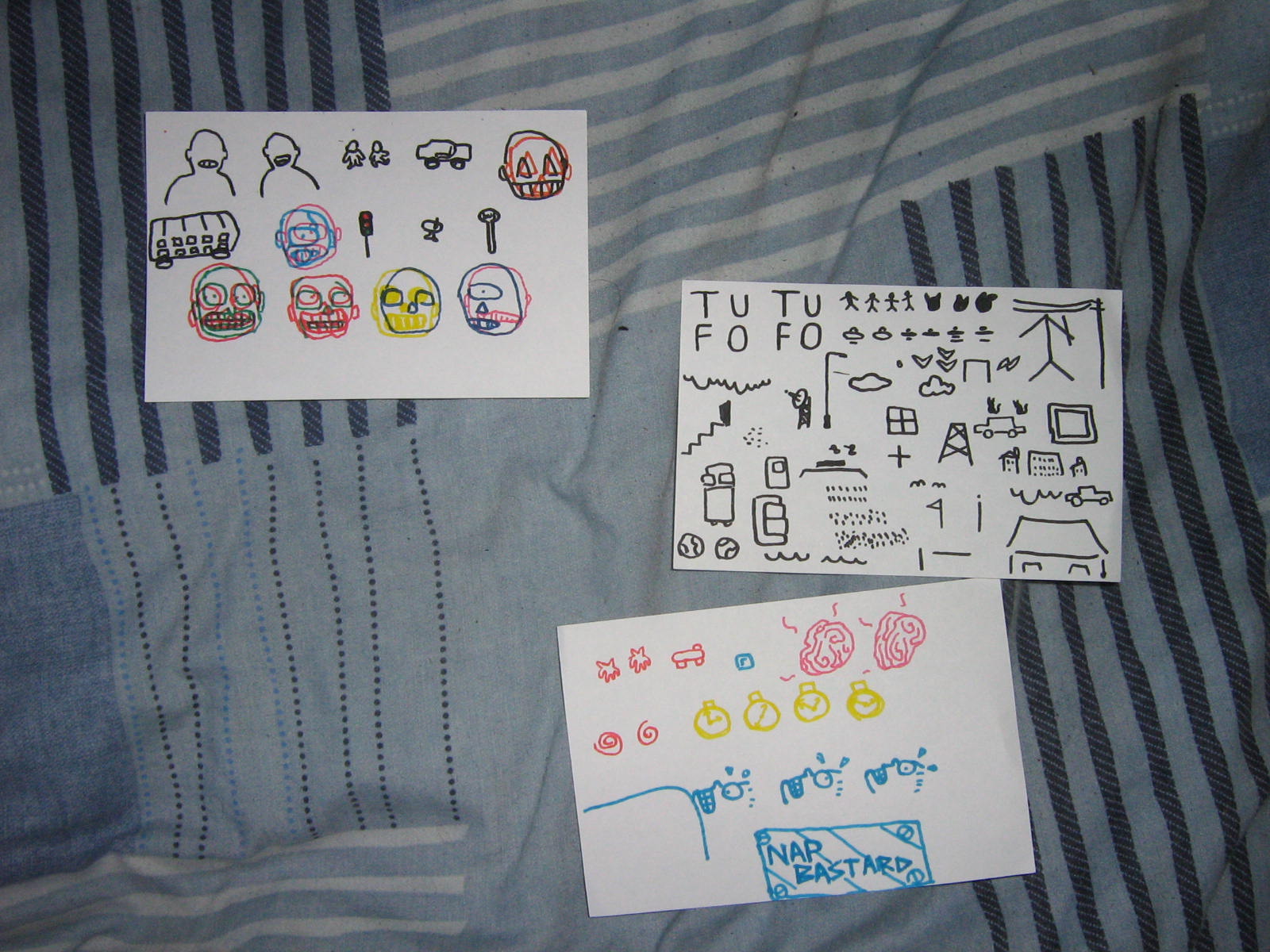
Some games which never got past initial drawings. "Nap Bastard" turned into Night Thoughts.
GROANING AT MY BABY:
I have often keenly felt the absence in videogames of a solid folk-blues tradition. Groans graciously provided by Lilith Megiddo.
ANCIENT WARRIORS:
When I was a kid and visited my relatives down the country in Cork I liked to go out into the fields and play games of "Transformers", where I picked up two huge dirtbombs and smashed them against each other until they disintegrated. This is kind of the same thing.
Out of the many, many occasions here of totally gratuitous text additions and changes in gameplay focus, I think this one works the best.
Drawing from recent events in my life (see entry for Lump Max) it even has possibly the first ever expression in my videogames of romantic desire for another sentient humanoid in the same room. The monsters were, very vaguely, based on my memories of "Tattoo Assassin".
CANDY PLANET:
Idea taken from the Silver Jews song "Candy Jail". By this point in the year I had moved back to my parents house as a temporary stopover before leaving Ireland with some of the money I'd saved from my day job. Rediscovering the luxuries of non-flat living (central heating!! a well-stocked fridge!!) sometimes made me feel a bit puffy and overwhelmed which is where some of this comes from.
THE QUIET MAN:
Based on a poster for the famous John Ford movie that I saw in a DVD store. Once I saw the title I thought to myself "BOY, he's quiet!!" and the rest of the game came from that. The music was sort of aiming for the same rhythm and feeling of Pere Ubu's song "Perfume"; not because it was especially relevant, more because I was listening to it a lot at the time.
AUF WIEDERSEHEN, MOGEY:
Just a goodbye :o)
  
APPENDIX:
BACKGROUND OF THE GAMES:
In 2013 I was very unhappy as a result of doing little. My spiritual torpor manifested itself as drinking exactly four beers each night while watching Superman: The Animated Series until it was time to sleep and go to work again and this went on for most of a year.
In 2012 I had finished a game "Goblet Grotto" in collaboration with associates Kat Lake and NEW VADERS, and I had also gotten my first fulltime job. To finish that game I was getting up at 5 in the morning and working 2-3 hours before walking into my job, since those were my best hours for getting things done. When that game finished I was naturally eager to put my newfound sense of discipline and experience of 3D to good use on one of the variety of ideas I had come up with during the past year. I had also moved into my own apartment and had privacy to work more at my own pace. As it happened I basically did nothing, for the reason that I wanted to play around with ideas and make things that were more looser and more nebulous than what I was doing previously but did not have the time, energy or technical ability to do that. The early morning method worked when I was plugging away within an established framework, but for starting a new project and especially one that would be as sloppy as I hoped it wasn't working.
For a while I experimented with new methods of working: I came up with a game about exploring outer space that would use handpainted graphics and a kind of disconnected modular picaresque structure, that would use various points of view and gameplay structures combining to give a total whole. This had advantages: handpainted 3d textures got me away from the computer and helped mitigate my slight hereditary arthritis or at least psychosomatic fear of same, and the modular format allowed for more compact and flexible working methods to go with the smaller time I had to work. As it happened, the technical difficulty of working in 3d and a large overall scope for the project still exceeded what I was able to do.
So I crashed again. I made a short game, again in 3d, called Lake Of Roaches for a gamejam and this kind of revitalised me and made me think about making smaller self-contained things and then maybe putting them in a pack and selling it (work was OK but like I say the time/energy usage was being felt sharply). I started work on another game but the pace was still too slow and it got bogged down. Some time passed. Someone invited me to make a quick 3d game for a glorioustrainwrecks competition; I did, and the result was abysmal. This was when I finally realised that whatever the merits of Unity the workflow was still not fluid enough for me to be able to play around with short ideas as much as I liked. I was very frustrated and immediately started scheming the release of another quick game, to "cover up" my ignonimous failure similar to what cats do. I remembered making a game for glorioustrainwrecks before that used Klik N Play, and I remembered the game very fondly (it's called "Gold's Enigma" and is available in the "short games" area of harmonyzone.org). While working on Goblet Grotto I had also been involved with Quimdung and made some short games in MMF2, essentially an upgraded Klik N Play, for their GameDog enterprise (still available for iOS!). I was also remembering some of the happiest times I'd spent with Adventure Game Studio where I would draw many tiny figures on a single sheet of paper and try to throw a game together from the results. The fun handdrawn process was similar to what I'd planned for the spaceship game. MMF2 was exactly as accessible and fluid as I could require. I bought some markers and had a game knocked together quite quickly and it dawned on me that this general working method would be a good framework for the general mucking about which I had wanted to do all year. In my defence, the notion of a commercial compilation only came about some nine days in.
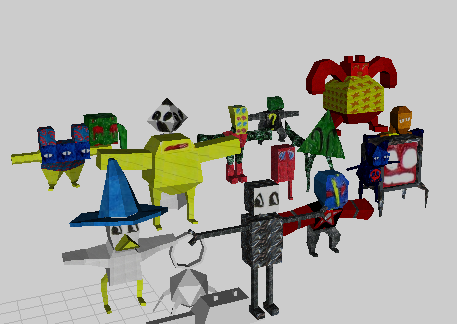
Character brainstorming for the astronaut game.
VOLUME OF THE GAMES:
I should mention that before I started making the games I had bought a book collection of James Kochalka's daily diary webcomic, American Elf, and it impressed me enormously. The book I had was four years of strips. They were very elastic in structure but usually pretty compressed: four panels would show a single moment from the day, without any further context, usually very slight and goofy. But the book had four years worth, and it was incredible to watch these very fragmented little slivers build into surprisingly subtle and cohesive total pictures of a life and the people in it as I read through. The strips seemed cut-off but they were each playing off and adding to a shared history, and sometimes off of other particular strips. They were also much looser and more encompassing than I'd first thought: they could include dreams, stupid jokes, sketches, experiments in perspective, abridgements of seperate incidents, corrections of previous strips. Some of them were just squiggly lines in a white panel denoting where the author was too drunk to work that day. It was very funny and exhilarating. I'm interested in the idea of that kind of ongoing multiplicity, for two reasons: one, the idea of steady production as a way of putting an artist in continual engagement with his or her own past work and the idea that this process would form a kind of crucible in which attempts to correct or repudate previous works, or revisitations of previous topics from a different perspective, would result in a gradual distillation and sharpening of their outlook (similar to Yeats constantly composting and negating his previous poetic personae). The other was that many loose things would allow a more oblique and circumspect perspective to emerge than might be allowed for within the constraints of a single focused work.You could use a variety of approaches to illuminate some aspect and their cumulation could be greater than the sum of the parts: for example the Minutemen's "Double Nickels On The Dime" assembling many short fragmented pieces which, because they were short and fragmented, could afford to experiment more with structure and voice in an exciting and novel way, but which still amounted to a coherent album.
On a personal level I wanted to overcompensate for my slothfulness at the beginning of the year, and frankly part of it too was that I really like working on these things, and that being able to do it when I got home from work was often the single thing preventing that day from being just another nail in the coffin. Egotistically I was also kind of worried about starting to have my games, even the short and shitty ones, get media notice at places like indiegames.com, and the prospect of having unsuspecting people play these short things while expecting actual big well-rounded ones was distressing to me. So I liked the idea of trying to outpace that stuff by just posting things CONSTANTLY, regardless of quality, with no indication of what was worth playing and what wasn't. And another reason is that I'm kind of fascinated by the idea of a culture of something, rather than by individual games. This is why many of my earliest things like Paul Moose In Space World were less actual games and more kind of weird fake signposts to a game, like a game you'd make to pull together the disparite screenshots of a Nintendo Power preview you saw when you were 9, or those old kung-fu movies comprised of archival footage.
Anyway, like I say, I had the idea of a compilation pack about a week or so in and that kind of locked me into it. Kochalka's comic strips were compiled into books, which both made them easier to read and which made the overall context more apparant; the Glorious Trainwrecks website puts out periodic "pirate karts" consisting of hundreds of titles from the website with a frontend loader, which are wonderful and how I experienced most of the games; the GameDog program I mentioned earlier was actually a whole fake console which assembled many great, bizarre scratchware titles from a variety of contributors. So I was already thinking about compilations and how they could offer a framework for many goofy, short ideas.

Unused fragments from a spreadsheet I kept at work.
SENSIBILITY OF THE GAMES:
I would describe the sensibility of these games as a kind of oscillating kitsch. Kitsch means pre-chewed art that saves time by simulating audience reaction as part of the work itself, like the laugh track in sitcoms (the set-up of the jokes invites some kind of response, which can be awkward if they're not that funny; having a reaction built-in releases the viewer from the effort of doing so and from the unnerving feeling of not being part of the community which the show is geared to). Traditionally this is seen as a bit of a cop-out of the idea of art challenging preconceptions, etc. What I find valuable about it is specifically in FAILED kitsch, where you can't actually identify the reaction being simulated and where the work has no actual affective power of its own, because this kind of opens up a negative space where you're finally able to hear yourself think and to see your own reactions. Most of the parts of videogames that I've enjoyed were the ones where I felt I was able to duck out of the implied affective journey of the game experience proper (don't you feel happy that you got the crystal? don't you feel sad that you got betrayed?) and find strange null areas. Like, instead of progressing to the next cutscene trigger in the military base you can just stay in this weird hillside area outside of it and wander around while the other units repeat decontextualised sound clips, and that sort of thing. One reason could be that the proposed emotional journeys embedded in these works have this standardising aspect, where the cumulative impact is to reinforce strict boundaries around what the appropriate emotional response to different stimuli is (as determined by a mandarin caste of californian media professionals). So they can feel hostile and overbearing, while trivial little pothole worlds can come as a relief.
I think these games and many of my videogames have a kind of similarly flat self-contained quality which comes from not giving the player an avenue for their own feelings inside the work, in ways which things like relateable characters or challenging action bits frequently do. Most of the games in this collection were built as after-dinner mints: totally insubstantial and dissolve instantly without mastication, but with a refreshing or piquant aftertaste. The idea was that you wouldn't really have to submit or engage to some authorial vision, you could kind of stand aside and watch the game play itself. There'd be the thing that the game was telling you it was, about shooting octopuses or whatever, but it'd have a framing perspective which changes what's actually being transmitted (the late Alex Chilton referred to this in music as when a song "lays an egg"). Like I say, most of what I've enjoyed in videogames hasn't been when what the game is doing matches up with my own desires: it's when the difference between the game's simulation of my desires and my actual reaction diverge enough to allow me moments of grace and clarity (also, it can be funny). The distant framing is a simulation of this feeling. Maybe an analogy is how some people sleep better listening to the static between radio stations.
Another point to keep in mind: these were mostly made after I came home from work, was tired, did not want to experience powerful emotional upheaval, thank you, get enuff of that at the office. So they're kind of made with similar mindset involved.
However, the crudeness and shortform aspect often means that the initial intent of the games fails, or gets diverted or rerouted into something else, and hence the kitsch factor oscillates as I would come across stuff that seemed funny or worked well or felt like something I wanted to say and then would be too lazy to go back and standardise the whole thing into a coherent whole. There can be a strange pathos about ineffectively sealed-off fictive worlds and hopefully you might find this entertaining in itself.
Additional references: Arabic geometrical art strenuously avoids mimetic representation as a kind of ward against idolatry, and the implicit disrespect to the autonomy of God's kingdom that is involved in turning it into a signifier for reproduction by human hands. Robert Walser's fictions could be considered analogous in the way each sentence tries to erase or mitigate the meaning of the one before, resulting in works which have been strenuously exhausted of meaning and use-value. Things which are small and ephemeral can act as negative reference points for reality, helping to delineate it by absence. Don't mind me, I'm just rehearsing what I'll tell my dad.
NOTE ON THE GRAPHICS:
I like tiny things and dioramas. I like the idea of a context emerging from a plainly artificial closed system of objects which take on a new meaning from being combined. Game graphic sets fascinate me and I sometimes put together ones for games that will never happen just to imagine what they'd be like (one of the reasons I don't like doing pixel art is because it plays to this pedantic masturbatory side of my nature). The markers were bought from an art n hobby shop in the Swan centre in Rathmines along with a pack of index cards. I typically used just one per game, but there were exceptions when I needed lotsa assets (like the Some Bee Ess game) and also false starts. When the index cards ran out I shifted to printer A4 paper, which actually led to a change in the games I was producing which generally became bigger and less focused. After a while I started folding them in half.
Once drawn the graphics were photographed with a digital camera, imported to my laptop, cut out in MS Paint (which was the real chore of all these games, frequently taking 2-3 hours: the actual game was made in 1-2 hours) and then imported into MMF2.
The graphics themselves tend to be based on simple principles. There are lots of little doodled block things, since it's an easier way of generating areas in a game than more complex assets (which may only be used once or twice and can't be modified too well). The animations are usually just the same thing drawn twice on the basis that any natural imperfections in reproduction will do the job of actually animating things. This especially goes for the title screens. The colour palettes became more predictable as the games went on and I found approaches which worked (all brown, hot pink + blue, blue + yellow, green doesn't work with ANYTHING, inverted palette and so on).
The problem of drawing faces as small as I wanted nagged at me and I was delighted to lapse back into the childhood technique of drawing 2 bubble eyes on top of a horizontal oval with vertical lines drawn through it and all placed on top of a stubby torso as a way of drawing tiny people.
The graphics were mostly drawn on my lunchbreak at work. I tended to go to the downstairs area of the coffee shop in the Georges St Arcade as it was quiet and nearby and full of nooks I could occupy.
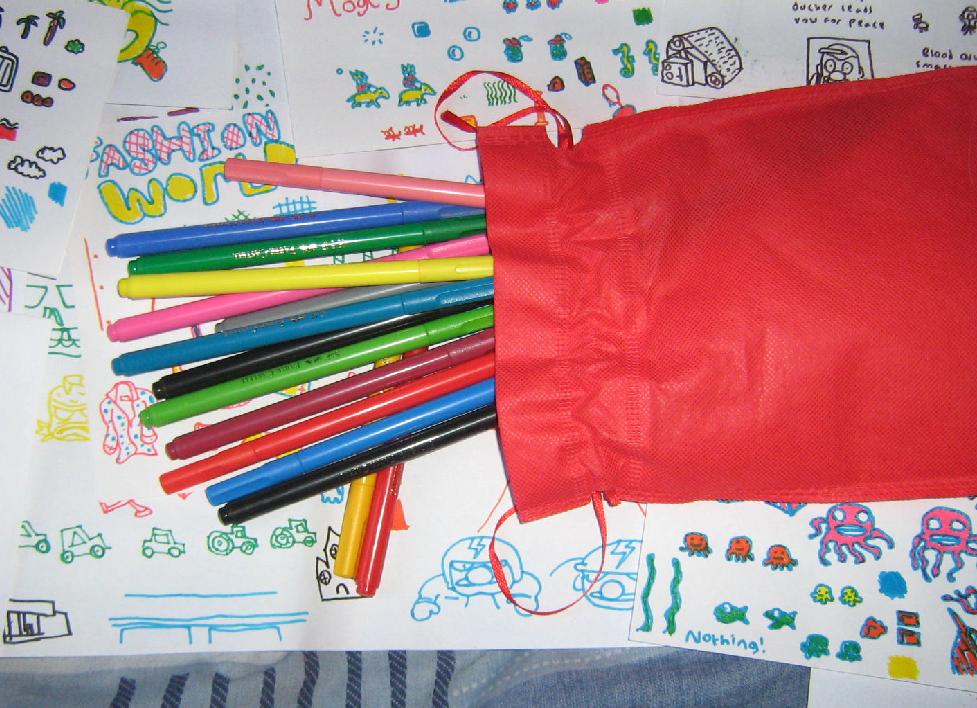
My little marker baggie.
NOTES ON THE TEXT:
A lot of what interests me about videogames is the way that montage and juxtaposition can be used to generate a cohesive-seeming space. I think videogames are analogous to animation in that while animation uses a succession of variated images to suggest continous motion, videogames use a succession of variated states to suggest continuous being. This can happen on different levels: there can be something like spatial movement within a frame (and I think this analogy explains something of why the simple fact of simulated spatial movement can be so exciting) and there can also be the variation of different modes of representation and interaction (eg shift from world map to battle system in squaresoft rpgs). The latter variation is similar to montage in that by reframing the two individual experiences it changes the meaning of each. Part of the appeal of videogames for me is how games which are on the face of it very, very stupid (eg Medal Of Honour Pacific Assault) can also be surprisingly ambiguous and occasionally disturbing just as a result of the way they're structured: do I NEED this background info in the mission briefing? Can I shoot that guy or is this a cutscene? I think one of the reasons Vasily Zotov's games are so offputting is because they kind of flatten out the dense heirarchial layers of framing that are the norm in videogames by projecting them all onto the same plane, so the GUI / score sections are actually lying around the landscape alongside enemies and symbolic representations of the kind of context you're supposed to be working in.
I like fluid and slippery media for the way it can elide the dreary and overbearing feelings that comes with standardisation of form (which is also standardisation of content natch), and part of the whole purpose of these tiny games for me was the opportunity to play around with structure in ways which might not be sustainable for longer games. How text fits into this is that it's (a) cheap in the sense of easy to add, remove or modify and (b) strangely self-contained since as many people have pointed out there are no real points where language and its referants actually intersect. In other words text can be slapped against an otherwise routine game or level and immediately add a kind of complicating extra dimension or reference point to it, similar to music. Since it's easy to change I often used it as a kind of ligament for chaining together and recontextualising different experiences. In fact this sometimes happened overmuch - see note to Frank Tomato HD, and there were definitely times where I tried to redeem a mediocre idea by frantically piling up more text around it. But I think there's a lot more that can be done with it than anything that I did here.
NOTES ON THE SOUND:
I have long dreamed of being able to just throw out any old beepy synth rubbish over the top of my games to use as a readymade soundtrack ("Wow.. just like 'John Carpenter'") and Bosca Ceoil was the first program I've found that was simple enough to let me do it. It's effectively a program for developing short midi loops, which can be chained together into songs if you so wish, which never happened to me because I was invariably seduced by the looping aspect and my incurable pedantry into making endlessly repeating 2second jingles, typically to vile effect. Most of them have a simple "closed" structure that makes them particularly aggravating. Mostly the music was the last thing I did for a game and it was mostly done late at night, which explains a lot. My discoveries making music were that the Tuba is the most beautiful MIDI instrument and that the Ride Cymbal can effectively produce waves of crashing noise.
I do like some of the songs (particularly when they feature the tuba) and feel in general that most videogame music is more complicated than it has to be as a result of the division of labour and resultant tendency to overspecialise (although the results can be interesting, eg Secret Of Mana). You can probably get away with just a single repeating beat as means of suggesting an additional sensual dimension to the videogame to what is on the screen.
CLOSING STATEMENTS:
I liked making the games. I hope you liked playing the games. I would advise anyone who is bored or unhappy and has access to a computer to start making regular little games, too.
|
